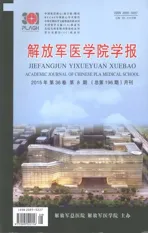术中CT导航技术在脊柱畸形手术中的应用
2015-03-21董天祥张永刚肖嵩华
吴 兵,董天祥,张永刚,肖嵩华
解放军总医院 骨科,北京 100853
术中CT导航技术在脊柱畸形手术中的应用
吴 兵,董天祥,张永刚,肖嵩华
解放军总医院 骨科,北京 100853
目的评价CT导航系统在脊柱畸形矫正手术中椎弓根螺钉置入的应用效果和技术优势。方法回顾性分析解放军总医院2010年1月- 2014年1月利用导航技术行手术治疗的脊柱畸形患者60例,其中男27例,女33例,平均年龄18.4(11 ~ 38)岁。通过西门子术中滑轨40排CT扫描后将原始数据转送给配备的Brainlab导航系统,辅助术者完成椎弓根钉置入。结果60例共置入椎弓根钉650根,胸椎570根(21根进行了修正),腰椎80根(无修正)。总置钉准确率98.14%,胸椎97.89%,腰椎100%。结论术中CT导航系统可以从各个角度实时显示准备置钉的椎弓根形态以及椎弓根钉前方组织,也可通过立体成像模块清晰显示进钉点与进钉角度,降低置入椎弓根螺钉时对椎弓根各壁的破坏概率和术中脊髓损伤的发生率,具有良好的应用前景。
术中CT;导航;脊柱畸形;椎弓根钉置入
脊柱畸形影响患者外观,严重时可导致脊髓功能障碍,甚至截瘫;因此,脊柱矫形对改善畸形及神经症状具有重要作用[1]。椎弓根钉棒系统具有强大的三维矫形能力,广泛应用于脊柱外科的各个领域[1-2]。矫形效果与椎弓根螺钉置入的准确程度密切相关,但畸形导致的椎体形态及位置的变化增加了置钉难度[3]。随着计算机可视化技术的飞速进步,出现了“影像导航手术”这一崭新的领域。我院引进国内首台术中CT导航系统(Siemens术中滑轨式螺旋CT配备Brainlab VVSky导航技术,德国),并在脊柱畸形手术中得到应用。本文旨在探讨CT导航系统在椎弓根螺钉置入时的应用价值。
资料和方法
1 病例资料 选取我科2010年1月- 2014年1月收治的行脊柱矫形患者60例,均有不同程度的冠状面、矢状面、横断面的三维畸形;其中男性27例,女性33例,平均年龄18.4(11 ~ 38)岁。
2 导航前准备 患者置于JUPITER系列360°转运全电动全碳纤维透视手术床,均在气管插管全麻下手术。取脊柱后正中切口,切开皮肤、皮下组织,显露棘突,骨膜下两侧剥离椎旁肌。显露范围包括上、下固定融合椎在内的融合节段椎体后部结构,应用专用脊柱导航夹固定棘突。
3 导航系统操作 1)CT及导航设备准备:安装导航器械,将红外导航球固定于导航器械上,术者将导航参考架固定于已经显露的手术区域内任一棘突上,最终确保导航参考架与患者之间相对位置保持不变。2)扫描:行全脊柱扫描,为减少照射剂量,设置成年人参数:100 kV,190 mAs,层厚10 mm,重建层厚1.5 mm,矩阵24 mm×1.2 mm,Pitch 0.9,Kernel B20S,Window Osteo,CTDIvol 10.1 mGy。未成年人参数:80 kV,120 mAs,层厚10 mm,重建层厚1.5 mm,矩阵24 mm×1.2 mm,Pitch 1.3,Kernel B20S,Window Osteo,CTDIvol 4.3 mGy。3)数据传输:将数据传输至导航系统,由导航系统根据病人手术体位、导航系统红外检测器、iCT空间位置监测点、固定于患者棘突上的导航参考架等的空间位置关系把原始数据重组,经计算机D/A转换和三维成像后,在显示器上显示出冠状位、失状位、横断位图像。4)导航:导航开始前要确定导航准确性,术者将导航探针置于显露的任一脊柱结构上,观察导航图像显示的结构是否与探针所点结构相同,如相同可进入下一步(此步骤为验证必须步骤,计算机默认必须完成此步才能进入下一步,在以往手术中两者相同率达到100%)。将常规导航手术器械尖锥、开路锥通过红外导航摄像机和红外导航球进行注册匹配。术者将手术器械尖部置于椎弓根后缘皮质上,在导航影像上清晰准确地显示进钉点、进钉方向、深度和所选用的内置钉长度和直径;同时在导航计划模块中,可以预先设置模拟螺钉的长度和直径,使得术者更加直观了解进钉情况以及螺钉与椎弓根内外侧壁和上下侧壁的位置关系,以便选择最佳路径置钉。在基础导航模块中,可清晰显示手术器械尖部前方1 mm、5 mm、10 mm、15 mm处的组织结构。5)CT扫描验证:在导航系统引导下完成置钉后,以同样的扫描条件进行扫描,得到患者术后CT数据,并可对导航系统引导下置钉的准确性进行评估。见图1。

图 1 CT影像重建后的导航路径A: 横断面; B:矢状面; C: 三维立体效果图; D: 进针点前方0 cm、 0.5 cm、 1.0 cm、 1.5 cm的组织结构Fig. 1 Navigation path after CT image reconstructionA: transverse section; B: sagittal plane; C: image of 3D restruction; D: structure front of entry point at 0 cm, 0.5 cm, 1.0 cm, 1.5 cm
4 椎弓根螺钉位置评估 采用Modi等[4]方法评价螺钉位置:0级:未突破椎弓根内外侧皮质(完全在椎弓根皮质内);1级:突破椎弓根内外侧皮质<2.0 mm;2级:突破椎弓根内外侧皮质2.1 ~ 4.0 mm;3级:突破椎弓根内外侧皮质4.1 ~ 6.0 mm;4级:突破椎弓根内外侧皮质>6.0 mm。突破椎体前方皮质分级方法同上。0级的螺钉属于准确置钉;椎弓根内侧皮质及椎体前方皮质分级≤1级和椎弓根外侧皮质≤2级为安全置钉;椎弓根内侧皮质及椎体前方皮质分级>1级和椎弓根外侧皮质>2级为潜在危险置钉。
结 果
术中CT导航系统辅助下,60例患者共置入椎弓根螺钉650根,胸椎570根,腰椎80根;其中胸椎螺钉中12根进行了修正(导航坐标漂浮误差),并一次性成功,见(图2)。总置钉准确率达到98.14%,胸椎97.89%,腰椎100%;胸椎螺钉失误率2.1%。

图 2 利用导航技术置钉后CT扫描横断面A: 腰椎置钉后影像; B: 胸椎置钉后影像Fig. 2 Cross-sectional CT scanning after navigationA:image of lumbar pedicle screws; B: image of thoracic pedicle screws
讨 论
脊柱矫形手术置入椎弓根螺钉时,由于存在椎体结构缺陷、脊椎三维畸形脊髓位置异常等情况,螺钉置入的难度和脊髓损伤的风险大大增加[5-6]。
普通X线片所获得的仅仅是骨性结构的二维重叠影像,而且对骨性结构的显示并不令人满意;加之组织器官的重叠,对椎旁软组织的显示有一定限度[7],在置钉后行C形臂透视检查置钉效果时由于二维图像只显示平面效果,对于螺钉与椎弓根内壁的位置关系显示不佳,甚至是误判,从而无谓地增加手术时间和出血量。据报道,即使经验丰富的术者,传统C臂X线机下徒手置钉失误率也在4.5% ~ 15.7%[8-9],严重影响术后矫形效果及预后。
术中CT导航系统是以CT影像数据为基础,螺旋CT扫描速度快,成像速度快,密度分辨率高,Z轴方向分辨率高,数据精确性高,对于导航系统的定位精确性起到了不可替代的作用[10],且三维重建技术可以进一步确定畸形的结构特点,发现平片不能发现的异常变化,如脊髓纵裂、锥体畸形等。
导航系统运用虚拟技术,借助光学定位仪跟踪,在计算机中建立一个虚拟环境,显示手术器械相对于病变组织的位置,从而实现对手术全过程的实时引导。通过术前重建的虚拟坐标系与术中的工作空间坐标系配准,可将跟踪设备跟踪到的手术器械和感兴趣的目标并实时显示在术前重建的虚拟解剖结构上,使术者实时观察手术器械和其周围的解剖结构以及手术器械的前进和后退、手术线路、测量置入物的角度、长度及直径,继而使术者在手术中能够实时观察手术机械和置入物在患者体内的空间位置,从而给复杂形态椎体的椎弓根螺钉置入带来极大的便利和优越性[9,11],CT导航系统实现了术中实时解剖结构的可视化,可观察多平面图像,特别是导航系统中三维立体成像模块更便于术者观察手术器械的实施路径和器械尖端的实时位置,辅助医生选择最佳的手术路径,使手术更快速、更精确、更安全[8,12]。
术中CT导航系统定位精确,实时性强,操作简单,图像清晰程度高,降低椎弓根螺钉置入的难度和术中发生脊髓损伤的概率。但是导航技术才刚刚起步,在导航坐标漂移误差方面还需要进一步的改进[13]。由此可见,术中CT导航系统在脊柱矫形领域具有重要的价值和广阔的发展前景。
1 Yu CH, Chen PQ, Ma SC, et al. Segmental correction of adolescent idiopathic scoliosis by all-screw fixation method in adolescents and young adults. minimum 5 years follow-up with SF-36 questionnaire[J]. Scoliosis, 2012, 7:5.
2 Sucato DJ. Management of severe spinal deformity: scoliosis and kyphosis[J]. Spine (Phila Pa 1976), 2010, 35(25): 2186-2192.
3 Devito DP, Kaplan L, Dietl R, et al. Clinical acceptance and accuracy assessment of spinal implants guided with SpineAssist surgical robot: retrospective study[J]. Spine (Phila Pa 1976),2010, 35(24): 2109-2115.
4 Modi H, Suh SW, Song HR, et al. Accuracy of thoracic pedicle screw placement in scoliosis using the ideal pedicle entry point during the freehand technique[J]. Int Orthop, 2009, 33(2):469-475.
5 Smorgick Y, Settecerri JJ, Baker KC, et al. Spinal cord position in adolescent idiopathic scoliosis[J]. J Pediatr Orthop, 2012, 32(5):500-503.
6 Modi HN, Suh SW, Fernandez H, et al. Accuracy and safety of pedicle screw placement in neuromuscular scoliosis with free-hand technique[J]. Eur Spine J, 2008, 17(12): 1686-1696.
7 张朝利,耿振林,王宗烨,等.脊柱侧弯术前CT检查的应用价值[J].中国医学影像学杂志,2002,10(3):192-193.
8 Nakanishi K, Tanaka M, Misawa H, et al. Usefulness of a navigation system in surgery for scoliosis: segmental pedicle screw fixation in the treatment[J]. Arch Orthop Trauma Surg, 2009, 129(9):1211-1218.
9 Gelalis ID, Paschos NK, Pakos EE, et al. Accuracy of pedicle screw placement: a systematic review of prospective in vivo studies comparing free hand, fluoroscopy guidance and navigation techniques[J]. Eur Spine J, 2012, 21(2): 247-255.
10 V Rajan V, Kamath V, Shetty AP, et al. Iso-C3D navigation assisted pedicle screw placement in deformities of the cervical and thoracic spine[J]. Indian J Orthop, 2010, 44(2): 163-168.
11 Metz LN, Burch S. Computer-assisted surgical planning and imageguided surgical navigation in refractory adult scoliosis surgery: case report and review of the literature[J]. Spine (Phila Pa 1976),2008, 33(9): E287-E292.
12 Cui G, Wang Y, Kao TH, et al. Application of intraoperative computed tomography with or without navigation system in surgical correction of spinal deformity: a preliminary result of 59 consecutive human cases[J]. Spine (Phila Pa 1976), 2012, 37(10):891-900.
13 Larson AN, Santos ER, Polly DW, et al. Pediatric pedicle screw placement using intraoperative computed tomography and 3-dimensional image-guided navigation[J]. Spine (Phila Pa 1976), 2012, 37(3): E188-E194.
Application of intraoperative CT navigation technology in spinal deformity surgery
WU Bing, DONG Tianxiang, ZHANG Yonggang, XIAO Songhua
Department of Orthopedics, Chinese PLA General Hospital, Beijing 100853, China
ObjectiveTo evaluate the application effect and technical advantages of intraoperative CT navigation system in the process of insertion of pedicle screws during spinal deformity operation.MethodsClinical data about 60 cases who underwent spinal deformity surgery and were assisted by Siemens intraoperative slide 40 row CT scanning and Brainlab navigation system to insert pedicle screws in Chinese PLA General Hospital from January 2010 to January 2014 , including 27 males and 33 females with an average age of 18.4 years (range from 11-38 years), were retrospectively analyzed.Results650 pedicle screws were inserted in 60 cases, including 570 thoracic pedicle screws (12 screws were modified) and 80 lumbar pedicle screws (none was modified). The total, thoracic and lumbar accuracy of the placement of pedicle screws were 98.14%, 97.89% and 100%, respectively.ConclusionThe intraoperative CT navigation system can display the form of thoracic and lumbar pedicle and the organization in front of the pedicle, and it can also precisely display the enter point and the angle of screw by three-dimensional imaging modules with low failure probability of pedicle and wall, low incidence of spinal cord injury and good application prospect.
intraoperative CT; navigation; spinal deformity; pedicle screw implantation
R 682.3
A
2095-5227(2015)06-0568-04
10.3969/j.issn.2095-5227.2015.06.012
时间:2015-03-10 09:39
http://www.cnki.net/kcms/detail/11.3275.R.20150310.0939.003.html
2014-10-27
吴兵,男,硕士,主治医师。Email: foxwu20002000@126. com;共同第一作者:董天祥,男,本科,技师。Email: 287586626 @qq.com
The first author: WU Bing. Email: foxwu20002000@126.com; DONG Tianxiang. Email: 287586626@qq.com
